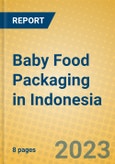Flexible aluminium/plastic remains a favoured pack type in dried baby food packaging for its practicality and versatility. This type of packaging provides excellent protection against moisture and maintains the nutritional integrity of the food. The trend towards smaller pack sizes, such as Nestlé’s 20g packs under its Cerelac brand, cater to the demand for convenient, single-serve portions that are ideal for on-the-go feeding.
The Baby Food Packaging in Indonesia report offers insight into key trends and developments driving packaging across the category. The report also examines trends and prospect for various pack types and closures: metal packaging, rigid plastic, glass, liquid cartons, paper-based containers; flexible packaging.
Product coverage: Dried Baby Food, Milk Formula, Other Baby Food, Prepared Baby Food.
Data coverage: Market sizes (historic and forecasts), company shares, brand shares and distribution data.
The Baby Food Packaging in Indonesia report offers insight into key trends and developments driving packaging across the category. The report also examines trends and prospect for various pack types and closures: metal packaging, rigid plastic, glass, liquid cartons, paper-based containers; flexible packaging.
Product coverage: Dried Baby Food, Milk Formula, Other Baby Food, Prepared Baby Food.
Data coverage: Market sizes (historic and forecasts), company shares, brand shares and distribution data.
Why buy this report?
- Get a detailed picture of the Baby Food Packaging market;
- Pinpoint growth sectors and identify factors driving change;
- Understand the competitive environment, the market’s major players and leading brands;
- Use five-year forecasts to assess how the market is predicted to develop.
Table of Contents
KEY DATA FINDINGS2023 DEVELOPMENTS
- Small pack sizes of dried baby food offer single-serve on-the-go solutions
- Eco- and user-friendly folding cartons the most popular baby food pack type
- Stand-up pouches gaining popularity in prepared baby food
- Folding cartons expected to grow in dried baby food due to rising sustainability concerns
- Strong growth expected for HDPE bottles in other baby food








